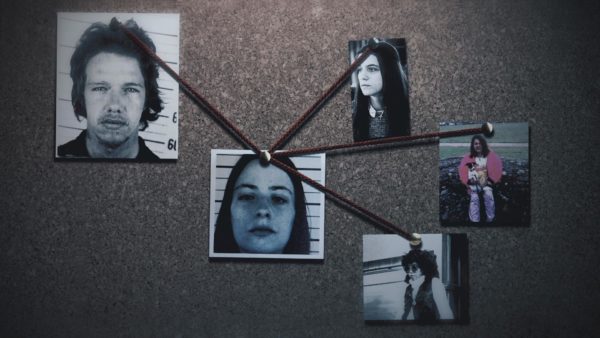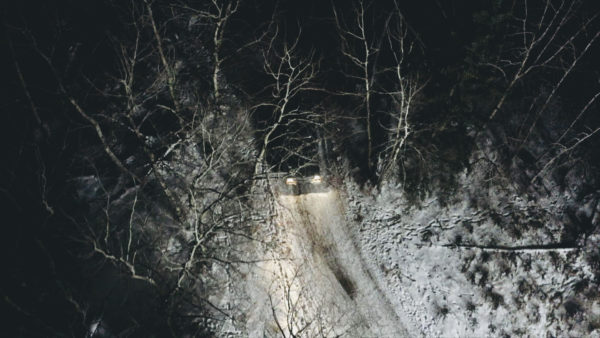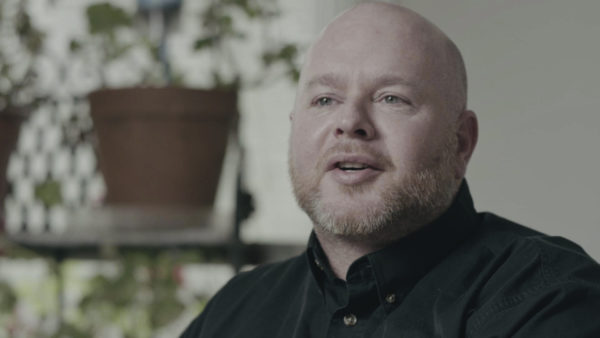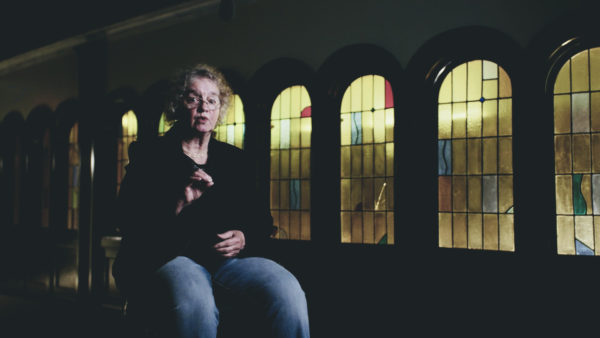
Each week, Terry and Joe discuss Blumhouse’s true-crime docuseries Fall River on EPIX. This week, we’re tackling episode 1.02.
Spoilers follow for Episode 2, “Deal With The Devil.”
Miss a Review? Episode 1
JOE
Hmm. Last week, when Fall River debuted, we had a couple of pretty significant criticisms: 1) the manipulative (and ostentatious) use of re-enactments and 2) the possibility that the series was angling for a wrongful conviction of Carl Drew.
Episode two, ‘Deal With The Devil’, winds up explicitly tackling the latter, while also dialling back on the former…and yet I’m still a bit on the fence about the whole project as a whole.
One of the challenges of this series is that, despite only being four episodes, it feels excessively and needlessly drawn out. This is, in large part, due to the recurring narrative structure, where ¾ of the episode focuses on facts (timelines, chronologies) before the final act pulls off some kind of shocking reveal to lure audiences back for the next episode.
In “My Soul To Keep” the twist in question is the revelation that Carl Drew may not have actually been responsible for the murder of Karen Marsden, the woman whose murder he is still in prison for.
“Deal With The Devil” pokes a number of holes in the case, mostly against Drew’s public defender John Birkness, who is noticeably absent and therefore unable to defend himself. Here Fall River not only confirms that most of the testimony against Drew was coerced and fabricated on the stand…but that Robin Murphy, Drew’s 17 year old competitor, was the mastermind behind the whole plot.
The fact that Robin worked the angles to get rid of her enemy isn’t actually that surprising (the first episode made it pretty evident that she wasn’t entirely trustworthy). What’s surprising, then, is that Robin actually confesses everything about her duplicity during her 2004 parole hearing and still gets out! Terry, that’s the real shocker…and yet it basically goes unremarked upon in order to tease her interview with that will inevitably comprise episode three.
Which is…fine?
The biggest issue I’m having with Fall River is that it is soooo drawn out. These episodes are clocking in at 55 mins apiece, but this material could have been handled so much more efficiently.

Uncomfortably Fall River still delights in describing crimes of a sexual nature. Take, for instance, the expository section about the Satanic Panic featuring podcaster and secular activist Seth Andrews and author and religious scholar Megan Goodwin. This bit is the only part of the episode that actually addresses the Satanism angle introduced (again, briefly) in episode one that Carl Drew was the leader of a Satanic cult who used his influence to kill two women.
In “Deal With The Devil”, Satanic Panic gets the CliffNotes treatment: it’s described as a 15 year phenomenon that swept the US in the wake of the publication of Michelle Remembers. The bestselling book prominently featured sexual abuse by parents and Satanic cult members, which is highlighted in Fall River, and then the show moves on to a police instructional video hilariously called ‘Law Enforcement Guide to Satanic Cults’ where the instructor mentions victims being made to perform fellatio.
I get the need to help audiences understand why adults became fixated on finding clues of Satanism in cartoons and cereal characters, but considering the brevity of screen time this all gets, focusing on the elements of sexual abuse comes off Fall River once again leaning into exploitative, button-pushing footage. Take, for instance, the moment when we’re told obsessive former police Sergeant Paul Carey dropped off milk crates of case files to budding PI Chris Hayes, who takes note of Doreen’s “stretched anal cavity” in the autopsy. Why is that very specific quote in there, Terry?!
I’m still moderately interested in the docuseries, but at the half way point, the egregious run time and continued reliance on “shocking” revelations and exploitative details are wearing thin.
What about you, Terry: did you enjoy the second episode more or less than the first? Were you happy that the re-enactments were traded out for actual court footage? And, we’ve not talked about it before, but do you think there are too many different talking heads?

TERRY
What’s interesting and ultimately frustrating about this episode, Joe, is that it buries the most fascinating part of the story surrounding Satanic Panic. While Fall River is ostensibly about the murders that happened in the late 70s, “Deal with the Devil” spends a significant chunk of its middle section discussing the history of satanic panic. From its foundations in the Cold War and the establishment of “In God we Trust” as the moral arbiter and central ethos of American culture to the book you mentioned above, episode two is at its most intriguing when it’s laying out the truth of this panic.
What I found most chilling, even amongst the horrendous murder the series is about, is the way Fall River ties the 80s idea of satanism as an Othering agent to the politics of the last few years. As horror fans, we’ve seen the way cinema and books have drawn inspiration from the 80s. Whether it’s the update to It or films and series like Stranger Things set in a nostalgic version of the time period, we’re cycling through that decade much in the same way the 80s cycled through the 50s.
And what’s a common thread that’s materializing between all three decades? The uptick in the religious right and the Othering of those they don’t like.
It was absolutely chilling to see Jon Voight mentioning that the “greatest fight” is against the lie that Biden won the election; that it was righteousness against Satan. And that leftists were Satanists.
That, coupled with the use of QAnon and its conspiracy theories surrounding the political left, shows that we haven’t evolved much since the 80s or the 50s. We’re stuck in an ouroboros of bigotry and oppression. That’s the most intriguing part of this episode.
This segment eclipsed the murder mystery and conviction of Carl Drew in terms of intrigue and importance. It made me want to see that docuseries, more than this sensationalist tragedy that’s unfolding.
That said, what I did find effective is the way Fall River compares the moral outcry and the pervading myth of satanism in America as a way of obfuscating what the trial was really about. Former crime reporter Maureen Boyle discusses how the focus was on secret ceremonies and hideouts in the forest where Satanists would do their incantations, explaining, “That’s not what this case is about.”
Private investigator (and part of Carl Drew’s post-conviction team) Chris Hayes puts it more bluntly: “it’s all a bunch of bullshit.” And ultimately, that’s exactly what this continued use of satanic panic is: a bunch of bullshit that distracts from what’s really going on. It creates two sides of a narrative…the righteous and the devil. In that regard, I found this episode more intriguing than the first, even though it mostly made me wish for a full-fledged examination of satanic panic over this tragic murder.

As for the talking heads…goodness, Joe. I had to literally write in my notes “Maureen Boyle — former crime reporter the standard-times, new bedford. (woman with the long hair black suit)” because after introducing her, they rarely (if ever) gave her name again. And while this episode focused a bit more on specific talking heads over the first episode where I gave up trying to annotate everyone they had on, it is verging on too many.
I’m of two minds on a few of the “experts.” On one hand, some seem to be there simply so that Fall River can dunk on them, like Alan Alves, the “Satanic Crimes” detective. On the other hand, the fact that he is considered an expert working at the time showcases how ignorant and conspiracy-filled the so-called specialists really are. While Alves didn’t come out and say it, the last segment with him, with the interviewer prodding him about the vast conspiracy that’s suppressing research into satanic crimes suggested he’s a QAnon follower.
I found the newest addition to the talking heads, though, to be quite charming. “Deal with the Devil” introduces Margo Charigbliss, a former court reporter, and she looks like a sweet granny, but seems to have more sense than most of the experts. Her assessment that “there is no proof. It’s what anybody believes at any given moment,” rings true of the way the trial seemed to unfold as well as the “truth” surrounding satanic crimes, in general.
Finally, the use of actual footage made me happy, but like the episode as a whole, it felt a bit redundant. The episode circled back to a shot of Robin looking dismayed in court one too many times. But I think it cuts to the heart of what you were saying, Joe, that Fall River feels a bit too padded. I would have preferred an entire episode devoted to the history of the rise of satanic panic, rather than the amount of time it spends going back over facts it had somewhat established in episode one.
Hopefully the series can right itself in the back half and bring everything together. Maybe we’ll see some progress next week as we go back to Gayly Dreadful for “Mark of the Beast.”
Fall River airs Sundays on EPIX.